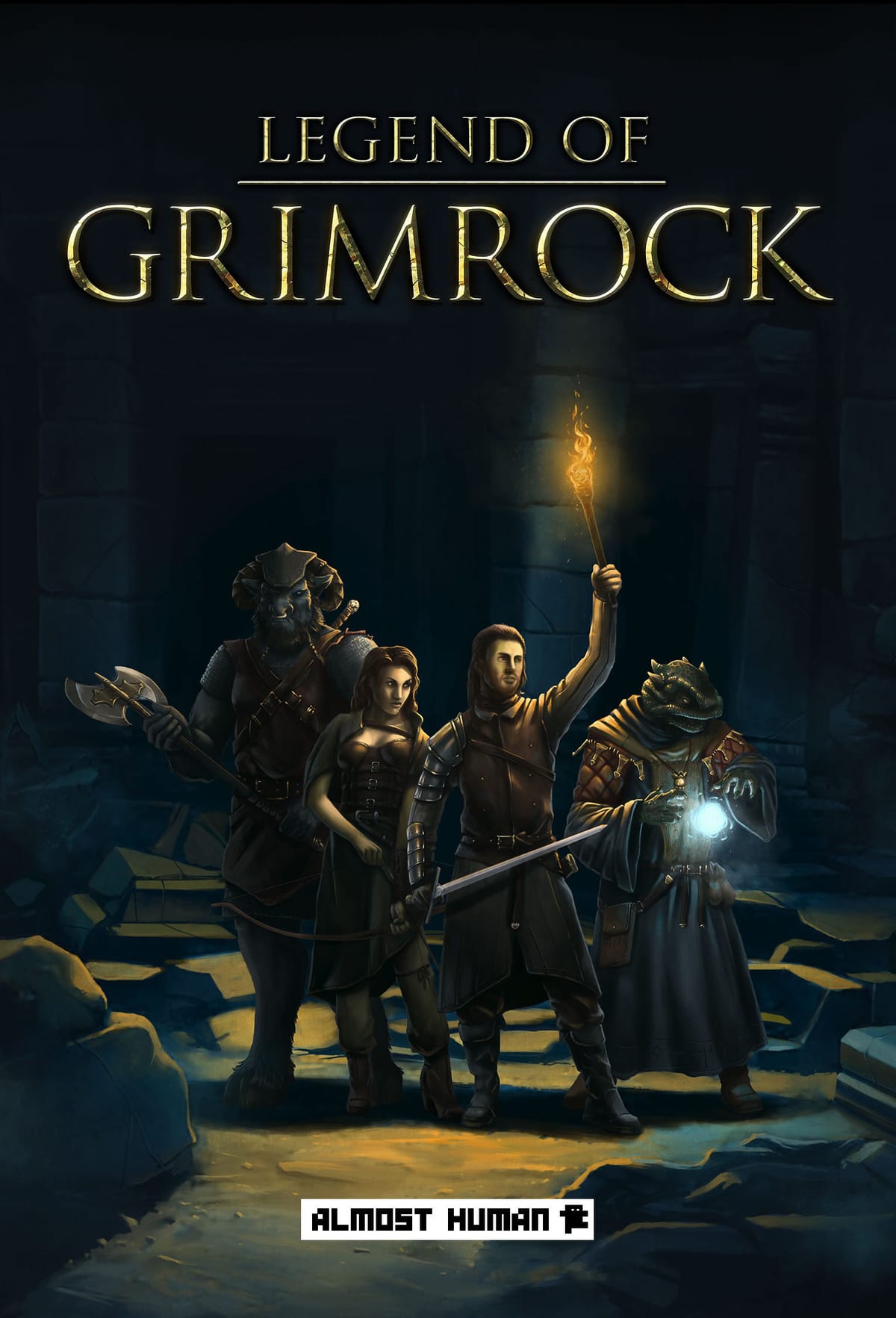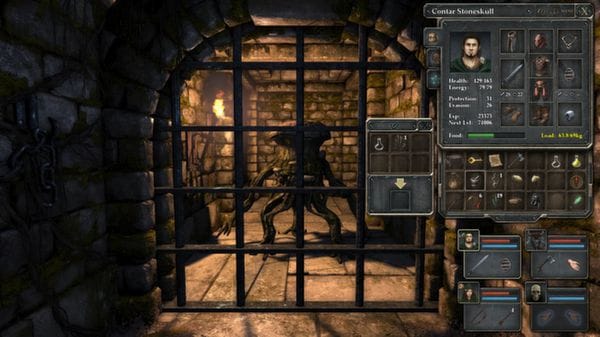On Legend of Grimrock

I'm fascinated by games like Legend of Grimrock. It is an adventure game, one focused on exploring a dungeon and finding what lies inside. There are also action RPG elements, even if it doesn't look like any other action RPG out there. The perfect execution of a simple concept is always worth exploring and dissecting, and Legend of Grimrock is my shining beacon of this phenomena.
This game is very complicated, so let me take a stab at painting a picture of how it works. The player creates up to four characters (and it should be four characters unless one is executing challenge run,) controlling their race and class, as well as their bonus traits and starting stats. From the powerful Minotaur and their ability to power up by holding onto skulls found in the dungeon, to Insectoid humanoids that have a chitinous shell to help block incoming attacks. Humans and Lizardmen round out the playable races, these last two being the more rounded characters. The three classes, Fighter, Thief, and Mage, have seven skills each which change the way they're played.
You start at the top of the dungeon and work your way down, exploring level by level in an old school dungeon crawl. Your four characters take up the single first person perspective, their marching order displayed in the bottom right hand corner of the screen. Their health and will power are on display, as well as their two equipment slots. Right clicking on an item in hand will have your character use it, be it sword or bow or torch. Certain weapons require your off hand to be filled with ammo, which you slowly build up as a reward for your exploration. Shields and torches can also fill your hands, as well as potions or anything you need during combat. That said, there isn't really pausing during combat, so you can even open your inventory and quaff potions from there if you're quick enough.

This is a hard user interface to grasp the first... dozen or so attempts I took at trying to crack this game. It is sort of like System Shock, where you aren't actually controlling your vision with the mouse, you are instead interacting with the world in front of you. This is a game where you MUST use the mouse and keyboard, I could not conceive of a way this would work without a mouse. There is something to be said about designing for input here. Using the mouse to control everyone's hands, and using the wasd/qe movement keys for feet, it's incredibly intuitive once you get a hold of it.
Okay, but why Grimrock?
So now that I've tried to explain the mechanics of this game, I need to explain why it is beloved. You see, this game is what happens when a team of people take a modern stab at an ancient type of game. The DNA of Gauntlet, Adventure(1980), and Colossal Cave Adventure runs through the veins of Legend of Grimrock, to the point where there is a mode where you have to create your own maps in order to explore the world. You know, with graph paper and a pencil, just like me making little mazes and dungeons in math class.
The soul of exploration is alive and well in this game. Hidden buttons, secret walls, locks placed about making you wonder about keys, making notes on your map, it's all here. The experience of holding one's breath before opening a door with loud clanging behind it or monster sounds is difficult to achieve, but Grimrock does it frequently. The game is incredible at making you earn your power through exploration, rewarding your efforts with powerful weapons and armor much earlier in the game than you would normally.
Speaking of powerful weapons, the combat in this game is unlike anything I've ever played. Since an entire hand is focused on movement, it makes sense that so much of this game is about dancing. You find out very quickly that sitting in front of an enemy, trading blows back and forth is a good way to wind up dead. Instead, the player is encouraged to maneuver through the space they are given, striking the enemy and then running away. Every step you take is a moment you are not being attacked, but is also a risk of stumbling down a hole or into an unexpected trap or baddie. Some enemies will have interesting movement patterns, like a crab being able to move to the side, or an ogre lashing out at you for flanking it. Some enemies attack at range, and others will have their own formation of multiple enemies in a single space. The game has a solid amount of enemy variety, usually giving you a new enemy type once every floor of the dungeon. This helps keep the game fresh, and tests your skills against more challenging enemies. Your projectiles will either stick into an enemy until they die, or if it's a blunt weapon fall to the ground after it strikes. Walking over your fallen ammunition has you automatically pick it up again if it's assigned to your hand slot, making it smooth to use a bow or throwing knives.
The last layer of this tasty video game lasagna is the amazing art direction. The enemies feel like they were stop motion animated, while the dungeon itself mixes up the walls and secrets every four floors or so. There is something special about learning what a hidden switch looks like, only for that earned knowledge to melt away in the face of new art assets. The sheer terror of finding an ogre for the first time, and the utter exhilaration to survive an encounter with a single adventurer alive, crawling half dead through the dungeon in search of a healing crystal. The soothing sound of the crystal reviving your allies, letting you automatically save and catch your breath, is one of the most cathartic experiences in the game.
Now for my controversial action: This time through Grimrock I played on hard mode, but made a deal with myself to sometimes use console commands to heal myself or give myself items when the game decides to eat ammo through a bug. No game is perfect, and sometimes you throw an axe down a hole, jump after it, and it's for some reason gone. Instead of railing against the game, I take some of my design knowledge and compensate. Meanwhile, being able to type party:heal() in the middle of combat is balance enough on hard mode, where sometimes a character goes from alive and well to a little skull in two hits. I find that if I can remove the things I find annoying about a game, things that end up being more time wasting measures instead of genuine challenge, I use what tools I have to make the experience more fun for me. If you don't like that, I honestly don't care because I am perfectly content with cheating in my single player games if it leads to more fun being had. I will say I've cheated the fun out of games before, hence my lens of only using console commands and other cheats to enhance the game, not break it wide open.
Conclusion: Fun
I don't go back to media very often. I have a pretty solid memory as far as stories and experiences goes, and yet from time to time I get bit with a desire to enjoy a flavor from the past. My most replayed games are Final Fantasy Tactics, MegaMan X, and Bloodborne, and I find I return to those because they're the best I've found at what they do. What they do best is engaging me and ease my anxiety about life. Legend of Grimrock has entered the short list of games I've played multiple times just because it's the best at the fun it creates. It's not like a comfort food game, seeking it's warm embrace to make you feel better in this terrifying world. It's more like that local Mexican restaurant that you try to drag everyone to because it's the best you've found in your entire state. It's wanting to get them to experience this momentary bliss, to receive the same message that you did from this group of people that made something incredible. Every single video game is a labor of love, and playing a single player game is like reading a message in a bottle written by multiple hands. It is crafting an experience that is repeatable, shareable, and immersive, just for other people to enjoy. That's the core of my love of video games, and why I will always delve back into the dungeon.